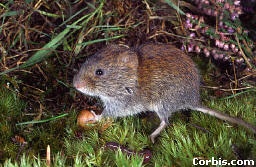|
A Day to Think of Voles
|
 |
It is a day when one thinks of voles. The dead leaves of our sycamore bestrew the ground with rumpled canopies under which an occasional field mouse will scurry. Sometimes, a brief parting of the grass will give away a white foot's presence. More rarely, a shrew will trundle from one fallen leaf to another, searching with whiskers and wit for whatever morsel it can bear back to its nest.
Soon everything will become quiet, and the snowfall will blanket the runways and burrows of this small space. For these little creatures, winter will bring an alternation of sleep and bare sustenance, a rhythm of breath and heartbeat, a long night's journey into a brighter sun.
On these days in late fall, my short steps travel miles as I try to tie word to bone and furry foot. A universe flattens and lowers to the level of the ground. Crowded stalks of grass tower above in the bending breeze, filtering the autumn light downward to a dusky dimness. Narrow passageways, their sides pleached with twigs and branches, form winding arteries through the decaying litter and stop abruptly at some dark tunnel or brambled nest. Vision is poor and only is scent acute in this vague world of root, leaf, vine and log. Soon a kind of kinetic memory stores the motions of repeated trips for food, the kind of memory a blind man acquires for visible objects in his room, and the daunting maze slowly becomes a clued and trusted path.
I think past time and feel this wild, precarious existence within myself. Some part of me knows it and shrinks from its crudeness, recoils from its perils. What we cannot know is an existence designed solely for each moment of fear, pain or pleasure; that given moment without past, present or future; an existence of a million moments, each of which is the only instant where one is conscious of existence itself.
Yet, what marvelous persistence of instinct this reveals. What exquisite sharpening of the senses for survival. What simple beauty in the timeless blend of energy and purpose. The mind is teased with the vastness of a lost reality.
I grow tall and rise on two legs far above the smell of leaf mold and entwining thicket. My memory wanders back to a sunny day in spring when the pine needles weighed lighter on the forest floor. Viva was young and eager for scents as we strode in those days through the woods on thunderous feet and thudding paws. Suddenly, from under a log, a movement caught Viva's eye. She pounced and grabbed the hapless victim in her jaws. She held it loosely, and I removed with my fingers a soft, warm body from her mouth. It was a vole. I placed it, lifeless, under the log which was its refuge. It had felt the approaching tremors of my footsteps and, seized with panic, tried to flee its imagined doom. One might say that it died of shock when it was grasped by the dog's open jaws. (Voles are said to be extremely vulnerable to loud noises, strong winds or impending terror, and often will not survive these shocks.) In memory of this minor tragedy, I named the site Vole Log. During the years that Viva and I walked this wooded pathway together, we never failed to pause before passing it. The log had a history and time had a name.
But the years are always afoot, and memory struggles with time's quickening pace. Today, Vole Log crumbles to dust like mouse and dog and last year's leaves. I seldom pass the place. My walking and my new companion take me elsewhere.
I once lived in another place that had a history of voles, one rare and famous. The following is from Hollis Koster's field notes of a specimen observed some years before we bought out property on the Mullica River. The Bill Birdsall referred to in the entry was the original owner:
A specimen of this rarely collected rodent (red-backed vole) is on record from Green Bank. Bill Birdsall's cat produced it & H. Koster put it in formalin and submitted to Roger Conant, Director of the Phila. Zoo. As this cat operated from present Reismiller residence, it is rather obvious that this rare mammal is present in lower Bull Creek Swamp. Ours, according to Hall and Kelson, is subspecies rhoadsii. Rhodes called it New Jersey wood vole, trapped specimens & thought it sparse in South Jersey cedar swamps. Stone writes, "I discovered this interesting mouse in a bog near May's Landing, Oct. 25, 1892. Since that time Mr. S.N. Rhoads and I have procured specimens from various parts of the pine barrens. To date, actual specimens are very few."
I have kept this note for years in one of Hollis Koster's annotated reference books which I inherited. I have read it many times an have often thought how many endless wondersthe present owners could discover if only they would take the time to look.
Yes, it is a day when one thinks of voles.
|